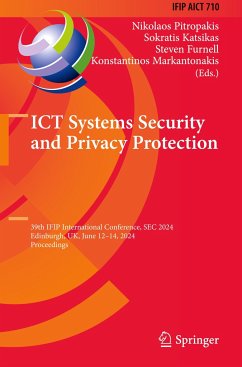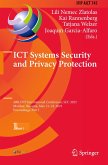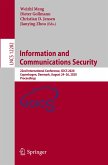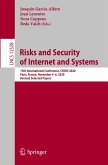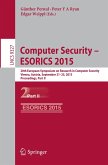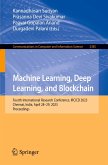ICT Systems Security and Privacy Protection
39th IFIP International Conference, SEC 2024, Edinburgh, UK, June 12-14, 2024, Proceedings
Herausgegeben:Pitropakis, Nikolaos; Katsikas, Sokratis; Furnell, Steven; Markantonakis, Konstantinos
ICT Systems Security and Privacy Protection
39th IFIP International Conference, SEC 2024, Edinburgh, UK, June 12-14, 2024, Proceedings
Herausgegeben:Pitropakis, Nikolaos; Katsikas, Sokratis; Furnell, Steven; Markantonakis, Konstantinos
- Gebundenes Buch
- Merkliste
- Auf die Merkliste
- Bewerten Bewerten
- Teilen
- Produkt teilen
- Produkterinnerung
- Produkterinnerung
This book constitutes the proceedings of the 39th IFIP International Conference on ICT Systems Security and Privacy Protection, SEC 2024, held in Edinburgh, UK, during June 12-14, 2024.
The 34 full papers presented were carefully reviewed and selected from 112 submissions. The conference focused on current and future IT Security and Privacy Challenges and also was a part of a series of well-established international conferences on Security and Privacy.
Andere Kunden interessierten sich auch für
![ICT Systems Security and Privacy Protection ICT Systems Security and Privacy Protection]() ICT Systems Security and Privacy Protection83,99 €
ICT Systems Security and Privacy Protection83,99 €![ICT Systems Security and Privacy Protection ICT Systems Security and Privacy Protection]() ICT Systems Security and Privacy Protection151,99 €
ICT Systems Security and Privacy Protection151,99 €![Information and Communications Security Information and Communications Security]() Information and Communications Security38,99 €
Information and Communications Security38,99 €![Risks and Security of Internet and Systems Risks and Security of Internet and Systems]() Risks and Security of Internet and Systems38,99 €
Risks and Security of Internet and Systems38,99 €![Computer Security -- ESORICS 2015 Computer Security -- ESORICS 2015]() Computer Security -- ESORICS 201539,99 €
Computer Security -- ESORICS 201539,99 €![Security and Privacy in Dynamic Environments Security and Privacy in Dynamic Environments]() Security and Privacy in Dynamic Environments113,99 €
Security and Privacy in Dynamic Environments113,99 €![Machine Learning, Deep Learning, and Blockchain Machine Learning, Deep Learning, and Blockchain]() Machine Learning, Deep Learning, and Blockchain83,99 €
Machine Learning, Deep Learning, and Blockchain83,99 €-
-
-
This book constitutes the proceedings of the 39th IFIP International Conference on ICT Systems Security and Privacy Protection, SEC 2024, held in Edinburgh, UK, during June 12-14, 2024.
The 34 full papers presented were carefully reviewed and selected from 112 submissions. The conference focused on current and future IT Security and Privacy Challenges and also was a part of a series of well-established international conferences on Security and Privacy.
The 34 full papers presented were carefully reviewed and selected from 112 submissions. The conference focused on current and future IT Security and Privacy Challenges and also was a part of a series of well-established international conferences on Security and Privacy.
Produktdetails
- Produktdetails
- IFIP Advances in Information and Communication Technology 710
- Verlag: Springer / Springer Nature Switzerland / Springer, Berlin
- Artikelnr. des Verlages: 978-3-031-65174-8
- 2024
- Seitenzahl: 512
- Erscheinungstermin: 26. Juli 2024
- Englisch
- Abmessung: 241mm x 160mm x 33mm
- Gewicht: 871g
- ISBN-13: 9783031651748
- ISBN-10: 303165174X
- Artikelnr.: 70896606
- Herstellerkennzeichnung
- Springer-Verlag GmbH
- Tiergartenstr. 17
- 69121 Heidelberg
- ProductSafety@springernature.com
- IFIP Advances in Information and Communication Technology 710
- Verlag: Springer / Springer Nature Switzerland / Springer, Berlin
- Artikelnr. des Verlages: 978-3-031-65174-8
- 2024
- Seitenzahl: 512
- Erscheinungstermin: 26. Juli 2024
- Englisch
- Abmessung: 241mm x 160mm x 33mm
- Gewicht: 871g
- ISBN-13: 9783031651748
- ISBN-10: 303165174X
- Artikelnr.: 70896606
- Herstellerkennzeichnung
- Springer-Verlag GmbH
- Tiergartenstr. 17
- 69121 Heidelberg
- ProductSafety@springernature.com
.- Towards a Mobility-Aware Trust Model for the Internet of Underwater Things.
.- Rasd: Semantic Shift Detection and Adaptation for Multi-Classification NIDS.
.- Reduce to the MACs - Privacy Friendly Generic Probe Requests.
.- PRIDA: PRIvacy-preserving Data Aggregation with multiple data customers.
.- Keep your memory dump shut: Unveiling data leaks in password managers.
.- DryJIN: Detecting Information Leaks in Android Applications.
.- Bruteware: A Novel Family of Cryptoviral Attacks.
.- Towards Practical Hardware Fingerprinting for Remote Attestation.
.- Examining the Strength of Three Word Passwords.
.- Can Synthetic Data preserve Manifold properties?.
.- "Alexa, How Do You Protect My Privacy?" A Quantitative Study of User Preferences and Requirements about Smart Speaker Privacy Settings.
.- Putting Authorization Servers on User-owned Devices in User-Managed Access.
.- Identification of cyber threats and vulnerabilities in Norwegian distribution networks.
.- Chain of trust: Unraveling references among Common Criteria certified products.
.- LightArmor: A Lightweight Trusted Operating System Isolation Approach for Mobile Systems.
.- Satellite: Effective and Efficient Stack Memory Protection Scheme for Unsafe Programming Languages.
.- Neurosymbolic learning in the XAI framework for enhanced cyberattack detection with expert knowledge integration.
.- Transforming EU Governance: The Digital Integration through EBSI and GLASS.
.- Malicious Insider Threat Detection Using Sentiment Analysis Of Social Media Topics.
.- A Structural-Semantic Approach Integrating Graph-based and Large Language Models Representation to Detect Android Malware.
.- Session Replication Attack through QR Code Sniffing in Passkey CTAP Registration.
.- GAD: A Real-time Gait Anomaly Detection System with Online Adaptive Learning.
.- Queuing Theoretic Analysis of Dynamic Attribute-based Access Control Systems.
.- IPEQ: Querying Multi-Attribute Records with Inner Product Encryption.
.- Hiding Your Awful Online Choices Made More Efficient and Secure: A New Privacy-Aware Recommender System.
.- Cognition Behind Access Control: A Usability Comparison of Rule and Category-based Mechanisms.
.- Obfuscating Code Vulnerabilities against Static Analysis in Android Apps.
.- Large Scale Heap Dump Embedding for Machine Learning: Predicting OpenSSH Key Locations.
.- Multi-Method Approach to Human Expertise, Automation, and Artificial Intelligence for Vulnerability Management.
.- Detecting Web Bots via Keystroke Dynamics.
.- Exploring a Low-Cost Hardware Reverse Engineering Approach: A Use Case Experiment.
.- Cross-validation for Detecting Label Poisoning Attacks: A Study on Random Forest Algorithm.
.- Xproofs: New Aggregatable and Maintainable Matrix Commitment with Optimal Proof Size.
.- Predicting the execution time of secure neural network inference.
.- Rasd: Semantic Shift Detection and Adaptation for Multi-Classification NIDS.
.- Reduce to the MACs - Privacy Friendly Generic Probe Requests.
.- PRIDA: PRIvacy-preserving Data Aggregation with multiple data customers.
.- Keep your memory dump shut: Unveiling data leaks in password managers.
.- DryJIN: Detecting Information Leaks in Android Applications.
.- Bruteware: A Novel Family of Cryptoviral Attacks.
.- Towards Practical Hardware Fingerprinting for Remote Attestation.
.- Examining the Strength of Three Word Passwords.
.- Can Synthetic Data preserve Manifold properties?.
.- "Alexa, How Do You Protect My Privacy?" A Quantitative Study of User Preferences and Requirements about Smart Speaker Privacy Settings.
.- Putting Authorization Servers on User-owned Devices in User-Managed Access.
.- Identification of cyber threats and vulnerabilities in Norwegian distribution networks.
.- Chain of trust: Unraveling references among Common Criteria certified products.
.- LightArmor: A Lightweight Trusted Operating System Isolation Approach for Mobile Systems.
.- Satellite: Effective and Efficient Stack Memory Protection Scheme for Unsafe Programming Languages.
.- Neurosymbolic learning in the XAI framework for enhanced cyberattack detection with expert knowledge integration.
.- Transforming EU Governance: The Digital Integration through EBSI and GLASS.
.- Malicious Insider Threat Detection Using Sentiment Analysis Of Social Media Topics.
.- A Structural-Semantic Approach Integrating Graph-based and Large Language Models Representation to Detect Android Malware.
.- Session Replication Attack through QR Code Sniffing in Passkey CTAP Registration.
.- GAD: A Real-time Gait Anomaly Detection System with Online Adaptive Learning.
.- Queuing Theoretic Analysis of Dynamic Attribute-based Access Control Systems.
.- IPEQ: Querying Multi-Attribute Records with Inner Product Encryption.
.- Hiding Your Awful Online Choices Made More Efficient and Secure: A New Privacy-Aware Recommender System.
.- Cognition Behind Access Control: A Usability Comparison of Rule and Category-based Mechanisms.
.- Obfuscating Code Vulnerabilities against Static Analysis in Android Apps.
.- Large Scale Heap Dump Embedding for Machine Learning: Predicting OpenSSH Key Locations.
.- Multi-Method Approach to Human Expertise, Automation, and Artificial Intelligence for Vulnerability Management.
.- Detecting Web Bots via Keystroke Dynamics.
.- Exploring a Low-Cost Hardware Reverse Engineering Approach: A Use Case Experiment.
.- Cross-validation for Detecting Label Poisoning Attacks: A Study on Random Forest Algorithm.
.- Xproofs: New Aggregatable and Maintainable Matrix Commitment with Optimal Proof Size.
.- Predicting the execution time of secure neural network inference.
.- Towards a Mobility-Aware Trust Model for the Internet of Underwater Things.
.- Rasd: Semantic Shift Detection and Adaptation for Multi-Classification NIDS.
.- Reduce to the MACs - Privacy Friendly Generic Probe Requests.
.- PRIDA: PRIvacy-preserving Data Aggregation with multiple data customers.
.- Keep your memory dump shut: Unveiling data leaks in password managers.
.- DryJIN: Detecting Information Leaks in Android Applications.
.- Bruteware: A Novel Family of Cryptoviral Attacks.
.- Towards Practical Hardware Fingerprinting for Remote Attestation.
.- Examining the Strength of Three Word Passwords.
.- Can Synthetic Data preserve Manifold properties?.
.- "Alexa, How Do You Protect My Privacy?" A Quantitative Study of User Preferences and Requirements about Smart Speaker Privacy Settings.
.- Putting Authorization Servers on User-owned Devices in User-Managed Access.
.- Identification of cyber threats and vulnerabilities in Norwegian distribution networks.
.- Chain of trust: Unraveling references among Common Criteria certified products.
.- LightArmor: A Lightweight Trusted Operating System Isolation Approach for Mobile Systems.
.- Satellite: Effective and Efficient Stack Memory Protection Scheme for Unsafe Programming Languages.
.- Neurosymbolic learning in the XAI framework for enhanced cyberattack detection with expert knowledge integration.
.- Transforming EU Governance: The Digital Integration through EBSI and GLASS.
.- Malicious Insider Threat Detection Using Sentiment Analysis Of Social Media Topics.
.- A Structural-Semantic Approach Integrating Graph-based and Large Language Models Representation to Detect Android Malware.
.- Session Replication Attack through QR Code Sniffing in Passkey CTAP Registration.
.- GAD: A Real-time Gait Anomaly Detection System with Online Adaptive Learning.
.- Queuing Theoretic Analysis of Dynamic Attribute-based Access Control Systems.
.- IPEQ: Querying Multi-Attribute Records with Inner Product Encryption.
.- Hiding Your Awful Online Choices Made More Efficient and Secure: A New Privacy-Aware Recommender System.
.- Cognition Behind Access Control: A Usability Comparison of Rule and Category-based Mechanisms.
.- Obfuscating Code Vulnerabilities against Static Analysis in Android Apps.
.- Large Scale Heap Dump Embedding for Machine Learning: Predicting OpenSSH Key Locations.
.- Multi-Method Approach to Human Expertise, Automation, and Artificial Intelligence for Vulnerability Management.
.- Detecting Web Bots via Keystroke Dynamics.
.- Exploring a Low-Cost Hardware Reverse Engineering Approach: A Use Case Experiment.
.- Cross-validation for Detecting Label Poisoning Attacks: A Study on Random Forest Algorithm.
.- Xproofs: New Aggregatable and Maintainable Matrix Commitment with Optimal Proof Size.
.- Predicting the execution time of secure neural network inference.
.- Rasd: Semantic Shift Detection and Adaptation for Multi-Classification NIDS.
.- Reduce to the MACs - Privacy Friendly Generic Probe Requests.
.- PRIDA: PRIvacy-preserving Data Aggregation with multiple data customers.
.- Keep your memory dump shut: Unveiling data leaks in password managers.
.- DryJIN: Detecting Information Leaks in Android Applications.
.- Bruteware: A Novel Family of Cryptoviral Attacks.
.- Towards Practical Hardware Fingerprinting for Remote Attestation.
.- Examining the Strength of Three Word Passwords.
.- Can Synthetic Data preserve Manifold properties?.
.- "Alexa, How Do You Protect My Privacy?" A Quantitative Study of User Preferences and Requirements about Smart Speaker Privacy Settings.
.- Putting Authorization Servers on User-owned Devices in User-Managed Access.
.- Identification of cyber threats and vulnerabilities in Norwegian distribution networks.
.- Chain of trust: Unraveling references among Common Criteria certified products.
.- LightArmor: A Lightweight Trusted Operating System Isolation Approach for Mobile Systems.
.- Satellite: Effective and Efficient Stack Memory Protection Scheme for Unsafe Programming Languages.
.- Neurosymbolic learning in the XAI framework for enhanced cyberattack detection with expert knowledge integration.
.- Transforming EU Governance: The Digital Integration through EBSI and GLASS.
.- Malicious Insider Threat Detection Using Sentiment Analysis Of Social Media Topics.
.- A Structural-Semantic Approach Integrating Graph-based and Large Language Models Representation to Detect Android Malware.
.- Session Replication Attack through QR Code Sniffing in Passkey CTAP Registration.
.- GAD: A Real-time Gait Anomaly Detection System with Online Adaptive Learning.
.- Queuing Theoretic Analysis of Dynamic Attribute-based Access Control Systems.
.- IPEQ: Querying Multi-Attribute Records with Inner Product Encryption.
.- Hiding Your Awful Online Choices Made More Efficient and Secure: A New Privacy-Aware Recommender System.
.- Cognition Behind Access Control: A Usability Comparison of Rule and Category-based Mechanisms.
.- Obfuscating Code Vulnerabilities against Static Analysis in Android Apps.
.- Large Scale Heap Dump Embedding for Machine Learning: Predicting OpenSSH Key Locations.
.- Multi-Method Approach to Human Expertise, Automation, and Artificial Intelligence for Vulnerability Management.
.- Detecting Web Bots via Keystroke Dynamics.
.- Exploring a Low-Cost Hardware Reverse Engineering Approach: A Use Case Experiment.
.- Cross-validation for Detecting Label Poisoning Attacks: A Study on Random Forest Algorithm.
.- Xproofs: New Aggregatable and Maintainable Matrix Commitment with Optimal Proof Size.
.- Predicting the execution time of secure neural network inference.

